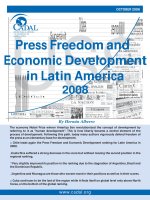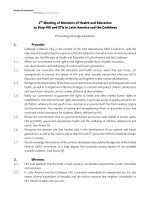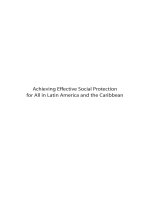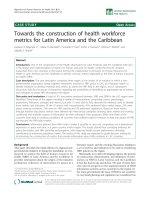Achieving Effective Social Protection For All In Latin America And The Caribbean - From Right To Reality doc
Bạn đang xem bản rút gọn của tài liệu. Xem và tải ngay bản đầy đủ của tài liệu tại đây (1.52 MB, 136 trang )
Achieving Effective Social Protection
for All in Latin America and the CaribbeanAchieving Effective Social
Protection for All in Latin
America and the Caribbean
From Right to Reality
Helena Ribe
David A. Robalino
Ian Walker
© 2010 The International Bank for Reconstruction and Development / The World Bank
1818 H Street NW
Washington DC 20433
Telephone: 202-473-1000
Internet: www.worldbank.org
E-mail:
All rights reserved
1 2 3 4 13 12 11 10
This volume is a product of the staff of the International Bank for Reconstruction and
Development / The World Bank. The findings, interpretations, and conclusions expressed in this
volume do not necessarily reflect the views of the Executive Directors of The World Bank or the
governments they represent.
The World Bank does not guarantee the accuracy of the data included in this work. The
boundaries, colors, denominations, and other information shown on any map in this work do not
imply any judgement on the part of The World Bank concerning the legal status of any territory
or the endorsement or acceptance of such boundaries.
Rights and Permissions
The material in this publication is copyrighted. Copying and/or transmitting portions or all of this
work without permission may be a violation of applicable law. The International Bank for
Reconstruction and Development / The World Bank encourages dissemination of its work and will
normally grant permission to reproduce portions of the work promptly.
For permission to photocopy or reprint any part of this work, please send a request with com-
plete information to the Copyright Clearance Center Inc., 222 Rosewood Drive, Danvers, MA
01923, USA; telephone: 978-750-8400; fax: 978-750-4470; Internet: www.copyright.com.
All other queries on rights and licenses, including subsidiary rights, should be addressed to the
Office of the Publisher, The World Bank, 1818 H Street NW, Washington, DC 20433, USA; fax:
202-522-2422; e-mail:
ISBN: 978-0-8213-8398-8
eISBN: 978-0-8213-8399-5
DOI: 10.1596/978-0-8213-8398-8
Cover art: Carla Robalino
Cover design: Quantum Think, Inc.
Library of Congress Cataloging-in-Publication Data
Ribe, Helena, 1949-
Achieving effective social protection for all in Latin America and the Caribbean : from right to
reality / Helena Ribe, David A. Robalino, and Ian Walker.
p. cm. — (Directions in development)
Includes bibliographical references and index.
ISBN 978-0-8213-8398-8 (alk. paper) — ISBN 978-0-8213-8399-5
1. Social security—Latin America. 2. Economic assistance, Domestic—Latin America. 3. Public
welfare—Latin America. I. Robalino, David A. II. Walker, Ian, 1957- III. World Bank. IV. Title.
HD7130.5.R53 2010
361.98—dc22
2010015476
v
Foreword ix
Acknowledgments xi
Abbreviations xiii
Overview 1
Introduction 7
References 10
Chapter 1 The State of Social Protection in Latin America
and the Caribbean: Recent Progress and Pending
Challenges 13
Recent Developments and Challenges in
SP Systems 14
Challenge I: Contributory Social Insurance
Coverage Remains Low and Limited to the
Formal Sector 15
Challenge II: LAC’s Social Insurance Systems
are Fragmented and Uncoordinated 21
Contents
vi Contents
Challenge III: Redistribution within the Social
Insurance Systems is Opaque, Often Regressive,
and Can Distort Incentives to Work and Save 27
Challenge IV: Enhancing the Effectiveness and
Human Capital Impact of Income Support
Programs 36
Challenge V: Increasing Access to Quality Jobs 44
Notes 47
References 49
Chapter 2 A Policy Framework for Social Protection in
Latin America and the Caribbean 53
Conceptual Framework: Understanding the
SP System 53
Policy Implications of the Conceptual
Framework 59
Opening Social Insurance Access to All 61
Reviewing the Mandates (Benefits Packages)
of Social Insurance Programs 62
Making Social Insurance Subsidy Systems
Transparent and Progressive 67
Making Social Protection Programs
More Coherent 72
Deepening Safety Nets and Facilitating Access
to Better Jobs 76
Notes 78
References 79
Chapter 3 Implications for Social Protection Programs 81
Pensions 81
Health 84
Unemployment Benefits 87
Active Labor Market Programs 89
Safety Net Programs 93
Strengthening Crisis Response Capacity 96
Notes 96
References 97
Chapter 4 The Trajectory of Reform 99
Reformers 100
Partial Reformers 102
Contents vii
Traditional Systems 104
The Way Forward 105
Note 107
Reference 107
Glossary 109
Index 113
Boxes
1.1 The Effect of Setting Workfare Wages Too High:
The Case of PLANE, Bolivia 43
2.1 The Limitations of Funding SI Entirely from General
Taxation in LAC 63
Figures
1.1 Contributory Pension Coverage in Latin America
and the Caribbean, 1990s to 2000s 16
1.2 Contributory Pension Coverage Rates in Latin America
and the Caribbean in the 2000s, by Quintile of per
Capita Income 17
1.3 Contributory Health Insurance Coverage in LAC,
Mid-2000s 18
1.4 Contributory Health Insurance Coverage in LAC,
Mid-2000s, by Decile of per Capita Income 19
1.5 Unemployment Insurance Savings Accounts per
Employed Worker 19
1.6 The Share of the Formal and Informal Sectors in LAC
Labor Markets 21
1.7 Contributory and Noncontributory Pension Coverage
among the Elderly by Income Quintiles and Source in
the 2000s 22
1.8 Contributory, Noncontributory, and Combined Health
Insurance Coverage in the Mid-2000s by Income
Quintiles and Source 23
1.9 Mandates of Pension Systems (average worker) 25
1.10 Mandates of Unemployment Benefit Systems
(average worker) 26
1.11 Implicit Taxes and Subsidies in the Brazilian
Pension System 29
viii Contents
1.12 Changes in Rates of Return on Contributions for
Pension Resulting from a One Percentage Point Increase
in the Growth Rate of Wages during a Working Life 30
1.13 Impact on Rate of Return on Contributions of Increasing
the Retirement Age from 65 to 70 32
1.14 The Impact on Choice of Informality and Increase in the
Effective Marginal Tax Rate on Formal Wages 35
1.15 Coverage of Income Transfer Programs in LAC 36
1.16 Cost of CCT Programs in LAC 37
1.17 GDP per Capita, Labor Productivity, and Employment
Growth 44
1.18 Tax Wedges in LAC Countries and the World 46
2.1 A Conceptual Framework for Social Protection 55
2.2 Examples of Different Mandates for Pensions 65
2.3 The Obligatory Mandate and Optional Additional Plans
of a Hypothetical Social Health Insurance System 66
2.4 Share of Social Security Contribution Rate Allocated to
Nonessential Benefits 75
4.1 Policy Innovations and Income per Capita 100
Tables
1.1 Contribution Densities in Argentina, Chile, and Uruguay 22
1.2 Institutional Integration of LAC’s SI Systems 24
1.3 Distribution of Subsidies to Social Insurance and Social
Assistance in LAC 31
2.1 Employment Barriers and Potential Corrective Measures 77
4.1 Initial Conditions That Affect Reforms 101
ix
Latin America remains the world’s most unequal region, and one where
poverty is therefore greater than it should be, given its level of economic
development. In the last decade, however, inequality fell in 12 of the 17
Latin American nations for which comparable data was available, and a
number of studies have attributed a non-trivial part of that decline to an
expansion in the continent’s social protection systems. In some countries,
an important share of the reduction in absolute poverty appears to have
been driven by large-scale social protection innovations, such as condi-
tional cash transfers and non-contributory “social” pensions.
Nevertheless, the very process of experimentation and organic growth
by which social assistance and social insurance programs have developed in
many countries has spawned an incomplete and fragmented system, posing
a number of challenges to the region’s policy makers. Contributory social
insurance coverage remains too low, and restricted to formal sector work-
ers. Redistribution within the social insurance system is usually opaque and
often regressive. Fragmentation and ill-designed redistribution also create
unintended disincentives for work and savings. And improvements in the
effectiveness with which social insurance instruments promote investment
in human capital and facilitate transitions into good jobs remain both nec-
essary and possible.
Foreword
Building on careful, detailed analysis of a wealth of data on social protec-
tion programs across Latin America and the Caribbean (LAC), this book
addresses these various challenges in a thorough yet accessible manner.
Although the analysis is comprehensive, the authors focus primarily on
three fundamental questions that must be faced by any effort to strengthen
social protection in the region: How to protect the most vulnerable with-
out promoting informality and dampening incentives to work and save.
How to ensure that scarce public resources are used for subsidies that are
transparent, fair, and effective and not for badly targeted and regressive ben-
efits for formal sector workers. How to reinforce human capital develop-
ment so the more mobile workers the region needs are able to insure
themselves through savings or risk pooling arrangements, reducing vulnera-
bility and the need for subsidies.
In providing thoughtful, evidence-based answers to these questions,
this volume makes an important contribution to a growing debate
among policy makers and social actors in LAC about the costs and inef-
ficiencies of what are at present dualistic systems of social insurance for
formal workers and social assistance for others. By necessity, that contri-
bution is informed by a deep understanding of how Latin American
labor markets work, and especially of the challenge posed by the preva-
lence of informality.
The authors develop a compelling, parsimonious conceptual framework
for the general principles of social protection reform, highlighting the
importance of the behavioral reactions of workers, firms, and service
providers to the rules and incentives embedded in social protection poli-
cies and programs. But their proposals are also rooted in an in-depth
knowledge of the complex realities of the region. They recognize that the
starting points, constraints, and social choices will vary by country, and
avoid the trap of recommending a simple blueprint. Rather, the book
invites policy makers everywhere to “step up” to the challenge of building
an integrated social protection system that treats the population equitably,
provides an inclusive safety net for all, promotes efficiency in service pro-
vision, and strengthens incentives to build a more flexible human capital,
to work, and to save. If that invitation is taken up, the results could com-
bine greater equity with a boost to the region’s economic performance.
Augusto de la Torre
Chief Economist
Latin America and the Caribbean Region
The World Bank
x Foreword
xi
This book highlights the main findings of a regional study by the World
Bank, From Right to Reality: How Latin America and the Caribbean Can
Achieve Universal Social Protection by Improving Redistribution and Adapting
Programs to Labor Markets (Ribe, Robalino, and Walker, with Kurowski,
Mason, Rofman, and Sánchez Puerta, forthcoming). This was commis-
sioned by the Chief Economist’s Office and prepared by the Social
Protection Unit in the Latin America and the Caribbean Region of the
World Bank under the supervision of Augusto de la Torre and Helena Ribe.
Andrew Mason was the initial task team leader, and David Robalino
became the task team leader until completion. Chapter authors for the
main study included Javier Baez, Andrew Mason, and Helena Ribe (recent
trends in Latin America and the Caribbean’s [LAC’s] social protection [SP]
systems); David Robalino and Eduardo Zylberstajn (labor markets); Rafael
Rofman and David Robalino (old-age income support); Christoph
Kurowski and Ian Walker (health); Francesca Lamanna, Helena Ribe, and Ian
Walker (income support safety nets); Maria Laura Sanchez Puerta and David
Robalino (unemployment insurance and active labor market programs); and
David Robalino, and Ian Walker (interactions between different elements of
the SP systems and cross-cutting challenges). Background papers and other
valuable inputs came from Pablo Acosta, Rodolfo Beazley, Fabio Bertranou,
Acknowledgments
xii Acknowledgments
Ramon Castano-Yepes, Aline Coudouel, Wendy Cunningham, Vanessa da
Silva Moreira, Mario di Filippo, Alvaro Forteza, Ariela Goldschimit, Jason
Hobbs, Theresa Jones, Ricardo Charles Manzano, Edmundo Murrugarra,
Christina Novinskey, Francisco Ochoa, Susan Parker, Jose Luis Salas,
Manuel Salazar, John Scott, Veronica Silva, Maria Concepcion Steta, Sarah
Thomson, Elio Valladares, Manuela Villar, Alejandro Yepes, and Eduardo
Zylberstajn. The team gratefully acknowledges the advice and comments
from Veronica Alaimo, Caridad Araujo, Laura Chioda, Tito Cordella,
Augusto de la Torre, Pablo Fajnzylber, Francisco Ferreira, Margaret Grosh,
Marcelo Giugale, Keith Hansen, Richard Hinz, Robert Holzmann, Dorothy
Kronick,William Maloney, John Nash,Ana Revenga, Gonzalo Reyes, Jamele
Rigolini, Jaime Saavedra, Ilias Skamnelos, Andras Uthoff, Salvador Valdés,
Milan Vodopivec, and Hélio Zylberstajn. Special thanks to Fiona
Mackintosh, Lerick Kebeck, Sandra León, and Julia Nannucci, who con-
tributed to the editing and production of this report.
xiii
AFDC Aid for Families with Dependent Children program
ALMP active labor market program
CCT conditional cash transfer
DB defined benefit
DC defined contribution
EAP economically active population
EMTR effective marginal tax rate
GDP gross domestic product
IMSS Mexican social security institute
IRR internal rate of return
LAC Latin America and the Caribbean
LRMS labor market risk management system
NDC notional defined-contribution
NHS national health service
NQF national qualifications framework
OECD Organisation for Economic Co-operation and Development
PAYG pay-as-you-go
PLANE Plan Nacional de Empleo de Emergencia
PPP purchasing power parity
SHI social health insurance
Abbreviations
SI social insurance
SP social protection
UI unemployment insurance
TANF Temporary Assistance for Needy Families
UISA unemployment individual savings accounts
VAT value added tax
xiv Abbreviations
11
Slow progress in improving the coverage of Latin America and the
Caribbean’s (LAC’s) traditional social protection (SP) programs,
combined with the deepening of democracy, have led to calls for a new
social contract to provide effective social protection to all citizens. This
study reviews the state of SP in LAC, showing that coverage gaps, low
benefits, and inequity continue to plague many countries. Such prob-
lems are apparent in pensions, health, unemployment insurance, income
support, and labor market programs. As a result, many households are
insufficiently protected against the idiosyncratic shocks that can affect
anyone or against systemic shocks to the economy as a whole. This
problem has been made more pressing by the global economic crisis,
which threatens to increase poverty and further undermine the security
of many households.
This book highlights the main findings of a regional study by the World
Bank, From Right to Reality: How Latin America and the Caribbean Can
Achieve Universal Social Protection by Improving Redistribution and
Adapting Programs to Labor Markets (Ribe, Robalino, and Walker, forth-
coming). It shows that the reforms of the past two decades have
expanded SP coverage to the most vulnerable groups, but the process
has been uneven and ad hoc, creating a two-tier, fragmented system. As
is well known, LAC’s traditional SP system, based on mandatory
Overview
employee and employer contributions to social insurance (SI) funds,
including pensions, unemployment insurance, and health insurance, was
truncated, inequitable, and fiscally unsustainable. Two decades of reform
efforts have produced important advances. In many countries, contribu-
tory SI has been modernized, for example, through pension reforms to
improve fiscal sustainability and to correct distorted incentives. At the
same time, targeted, noncontributory mechanisms have been established
to provide income support and health services to those excluded from
contributory SI (above all, the poor and informal sector workers). The
benefits offered by such programs, however, often are markedly inferior
to those from traditional SI and contribute to the fragmentation of the
labor market.
The report analyzes LAC’s SI systems and highlights growing con-
cerns about the incentives they may create and the behaviors they
may incite on the part of workers, employers and service providers. It
offers an economic analysis of the roots of these problems and suggests
a way forward to achieve universal coverage in an equitable manner.
Tensions between system components can undermine beneficiaries’
incentives to work and to save, can reinforce individuals’ and firms’
incentives to operate informally, and can induce providers to duplicate
services and inflate costs. For example, overly generous safety net pro-
grams or badly designed non-contributory social insurance programs
may create incentives to informality and undermine contributory SI.
The report argues that a coherent overall vision for the SP system should
be established if such problems are to be understood and resolved. The
goal is to turn the theoretical right to social protection, which is enshrined
in many of the region’s constitutions and laws, into a reality for all of
LAC’s population.
A central message of the report is that SP systems need to respond to
the realities of LAC’s labor markets, especially the prevalence of infor-
mality and frequent changes of employment. It will be difficult to expand
the coverage of contributory SI so long as access is linked to having a for-
mal sector labor contract, informal sector workers are excluded and rules
on benefit entitlement are slanted against people who move jobs. Coverage
of SI is also unlikely to expand significantly without redistributive mech-
anisms that target individuals with limited savings capacity and the long-
term poor. It is important to make these mechanisms more transparent
and progressive, and to better integrate them with the general social
assistance system.
2 Achieving Effective Social Protection for All in Latin America and the Caribbean
Chapter 1 reviews the reforms of the last 20 years and the present
state of LAC’s SP systems and identifies five challenges facing SP policy
makers in LAC:
• Addressing the limited progress that has been made in extending SI cov-
erage. This is analyzed using new cross-country data on the scope of con-
tributory and noncontributory programs for old-age income support,
health, and unemployment protection.
• Reducing the fragmentation of institutional arrangements in SI, which
arises, in part, from the ad hoc development of subsidized programs
and leads to differentiated provision and benefit adequacy between
insurers and population groups.
• Changing the opaque and often regressive nature of financing and re-
distribution arrangements for SI and the associated lack of financial
sustainability for many programs and systems.
• Reinforcing the targeting and poverty reduction effects of income
transfer programs, to strengthen their impact on human capital accu-
mulation, improve their crisis response capacity, and ensure that they
do not incentivize informality in the labor market.
• Strengthening active labor market programs (ALMPs), to improve the
relevance of training programs, and increase the efficiency of the job-
search and matching process.
Chapter 2 develops a proposed policy framework for SP in LAC that
would facilitate an effective response to these challenges. It includes a
conceptual framework for understanding the objectives and elements of
an SP system, the interactions between instruments and programs within
the system, and their impact on the economy as a whole. It then uses this
framework to address the challenges outlined in chapter 1 and suggests a
way forward for increasing the coverage and adequacy of SP in LAC.
The conceptual framework highlights three objectives: (1) consumption
smoothing to deal with life-cycle income variations and with short-term
health and labor market risks; (2) poverty prevention (the social safety
net); and (3) human capital development. It identifies the instruments,
financing mechanisms and institutions that can help achieve these goals.
The framework emphasizes that—whatever programs, institutions, and
financing mechanisms are chosen—a successful SP system will have
regard for the behavioral responses of individuals, households, and SP
providers to the rules and incentives embedded in the system.
Overview 3
The chapter identifies a set of principles to improve the coherence of
the SP system and expand the coverage and adequacy of benefits,
while avoiding perverse incentives to reduce work and savings, to seek
informality, or to increase the costs of service provision. It proposes
the expansion of SI to all citizens, regardless of where they work.
Contributory systems would be integrated or harmonized and extended
to informal sector workers and the poor. To reduce distortions, contri-
butions would be directly linked to benefits, thus eliminating implicit
taxes and subsidies. Transparent, progressive subsidies would then be
used to help low-income workers with limited savings capacity to access
contributory SI. This, in turn, would allow targeted anti-poverty programs
such as conditional cash transfers (CCTs) to focus on helping extremely
poor and excluded households, with little or no savings capacity, to
increase their consumption, strengthen their human capital, and cope
with temporary shocks. The governance and design of labor market pro-
grams should be strengthened to improve access to “good quality” jobs
as a lasting way to reduce poverty and vulnerability. All these changes
should be accompanied by better integration and coordination of the
components of the social protection system.
Chapter 3 addresses the detailed implications for specific SP pro-
grams. It summarizes the main recommendations that flow from the con-
ceptual framework and the general approach to reform for the main types
of SP programs in LAC: old-age income protection and pensions; health
programs; active labor market programs; and targeted income support pro-
grams for the poor.
Chapter 4 discusses the trajectory of reform, showing how these ideas
could be implemented in countries with different points of departure.
This report’s review of lessons learned from the successes (and failures)
with past SP reforms aims to identify workable principles on which to
base a new phase of reforms. The goal should be to move toward a more
coherent, integrated, effective, and equitable SP system in the medium
term. The problems will not be resolved overnight, and advances will
sometimes be small, but a clear vision is needed to help policy makers
avoid piecemeal reforms that respond to short-term concerns and minor-
ity interests. Nevertheless, the report also argues for a pragmatic and tech-
nocratic approach, avoiding “universal models” and emphasizes that the
specific policies chosen will depend on each country’s initial conditions
and priorities.
The central ideas are simple. To turn the right to SP into a reality for all
the population in Latin America and the Caribbean, contributory SI should
4 Achieving Effective Social Protection for All in Latin America and the Caribbean
be opened up to informal sector workers on an optional basis with ade-
quate financial and institutional incentives; SI benefits should be aligned
with the value of contributions; and subsidies should be transparent, tar-
geted to workers with limited savings capacity, and financed out of general
taxation. Wherever possible, SI programs covering different populations or
risks should be consolidated and their benefits packages harmonized. At
the same time, safety net programs should be targeted based on poverty
criteria and program rules should avoid creating disincentives to work or
save. More emphasis should be placed on interventions that promote
human capital and reduce vulnerability by strengthening links from SP
programs to improved health, nutrition, and education outcomes. Policy
makers also need to improve the design of ALMPs to help the most vul-
nerable workers (especially young people entering the labor market and
low-income unskilled workers) get better quality jobs and avoid long-
term unemployment. Finally, care should be taken to coordinate policies
across different types of program to take advantage of potential synergies
and cross-effects and to avoid adopting policies with conflicting aims.
In summary, the report suggests five strategic themes for policy
reforms that could help countries in the LAC region move closer to mak-
ing the right to SP a reality for everyone:
•Open up contributory SI programs to all workers, regardless of where
they work. This means maintaining mandatory insurance in the formal
sector but also promoting the inclusion of informal sector workers in
contributory SI programs on an optional basis, with adequate financial
and institutional incentives.
• Review the mandates of SI programs. The objective is to make explicit
choices about the coverage and benefits to be offered to individuals
with different levels of income.These choices need to be adequate but
also efficient and affordable.
• Make subsidies transparent and progressive. The idea is to remove implicit
taxes and subsidies within SI programs and move toward a unified sys-
tem of subsidies that are targeted based on means.These subsidies would
decline gradually as the beneficiary’s income rose and would be financed
from general revenues. This would make redistribution more progressive
and avoid distorting incentives for workers and employers.
• Make SP systems more coherent by integrating or harmonizing parallel
programs and exploiting opportunities to share savings and insurance
pools between risks. Policy makers also need to rationalize the interac-
tions between SI, safety net programs, and ALMPs.
Overview 5
• Deepen the antipoverty social safety net and develop programs to facilitate
access to better jobs. Cash or in-kind transfers are needed for workers
and households in extreme poverty who have no capacity to partici-
pate in contributory SI, even with subsidies. A key objective is to en-
sure that these social safety nets encourage poor households to invest
in education, health, and nutrition to avoid the intergenerational trans-
mission of poverty. In parallel, ALMPs are needed to help low-income
and low-skilled workers increase their employability and to facilitate
labor mobility and job search. This can increase their earnings and re-
duce their economic vulnerability, thus relieving pressure on other el-
ements of the SP system.
6 Achieving Effective Social Protection for All in Latin America and the Caribbean
7
Latin America and the Caribbean (LAC) are known internationally as the
home of some of the world’s most innovative social protection (SP) pro-
grams and policies. In the last two decades, many LAC SP systems have
been transformed, and policies and spending on SP have increased in
importance in relation to other government policies and programs. Many
countries have reformed their pensions systems to make benefits com-
mensurate with savings and to reduce their fiscal exposure to future
deficits. Many countries have expanded or introduced targeted social
health insurance systems (SHI) that provide free or subsidized health care
to the poorest families. Perhaps most noteworthy has been the introduc-
tion of well-targeted conditional cash transfer systems that have brought
millions of poor families within the scope of SP for the first time and have
been adopted as a model by developing countries worldwide.
Notwithstanding this recent progress, much remains to be done to
turn the right to social protection—which is enshrined in the consti-
tutions and laws of most LAC countries—into a reality for the majority
of their populations. At the heart of this predicament is the very low cov-
erage of contributory social insurance (SI), which recent reforms have not
resolved. The main difficulty is that the region’s mandatory systems for
providing pensions, health insurance, and unemployment benefits are not
Introduction
apt to cover workers in the informal sector, who constitute a majority of
the labor force in most countries.
Another problem is that the SI systems in most LAC countries are
fragmented, meaning that parallel schemes exist that offer different ben-
efits to different segments of the labor force, even when they make simi-
lar contributions. This restrains labor mobility, creates inequalities, and
increases costs. To close the coverage gap, several countries have intro-
duced noncontributory SI programs (such as social pensions), but in some
cases this has created dual systems—worsening fragmentation—and may
have created incentives for informality.
In many countries, the SI system redistributes income between plan
members through the implicit effect of rules about contributions and
benefits. Although the original intention was to favor lower-income plan
members, in practice, the resulting redistribution is often regressive. In
addition, the resulting implicit taxes and subsidies distort incentives and
can induce evasion and other unintended behaviors, such as early retire-
ment or reduced work-search efforts. Implicit subsidies have caused seri-
ous problems of overall fiscal sustainability, because in practice, they are
not always fully financed by the contributions of plan members and their
employers. This results in pensions, unemployment benefits, and health
insurance systems running deficits, which must be financed from general
taxes on current and future generations.
Similarly, the region’s social assistance (SA) programs, which provide
targeted transfers to the poorest households, have yet to achieve their full
potential in terms of preventing poverty and promoting human capital
development. This is, in part, because of the poor quality of health and
education services provided to beneficiaries of conditional cash transfer
programs (CCTs). In addition, challenges related to the implementation
of SA programs in urban areas might undermine targeting outcomes, and
the effectiveness of their enrollment and exit mechanisms. For some types
of income transfer program, the potential for labor market disincentive
effects, similar to those arising from subsidized SI programs, is an issue.
Other challenges are associated with active labor market programs.
Many of these programs are not designed adequately to overcome the
constraints that make it hard for workers to have access to quality jobs.
Training—the main form of support offered in these programs—is often
supply driven and it benefits mostly formal sector workers. Job search
intermediation services and interventions to increase the labor market
opportunities of low-skilled workers, particularly young people, are
underdeveloped. The 2008–09 financial crisis has shown that LAC’s SP
8 Achieving Effective Social Protection for All in Latin America and the Caribbean
systems remain ill equipped to provide most workers with adequate pro-
tection against shocks. Many who lose their jobs will receive no compen-
sation to tide them over until their next job and will not have access to
employment services to help them find work.
The current socioeconomic environment in LAC counties is conducive
to addressing these challenges by reforming SP systems. Social consensus
is growing on the need for a more equitable distribution of income and
for social inclusion and a general recognition that better social protection
policies can contribute to achieving those goals.
This book highlights the main findings of a regional study by the World
Bank, From Right to Reality: How Latin America and the Caribbean Can
Achieve Universal Social Protection by Improving Redistribution and
Adapting Programs to Labor Markets (Ribe, Robalino, and Walker, forth-
coming). It takes stock of recent SP reforms in LAC and charts a way for-
ward to improve outcomes, in terms of program coverage and the
adequacy of benefits. It contributes to policy discussions about the design
of SI, social assistance, and labor market programs.
The report builds on an extensive literature about the reform of social
protection systems in LAC (de Ferranti et al. 2000; Gill, Packard, and
Yermo 2004; Baeza and Packard 2006; ECLAC 2006; Levy 2008; and
Grosh et al, 2008). A central theme is that a well-functioning SP system
must take into account the realities of the region’s labor markets, espe-
cially the persistence of high levels of informal sector employment, where
it is difficult for governments to impose mandates such as compulsory SI.
It also should take into account the likely effects of policies and programs
on the behavior of their beneficiaries and of service providers, through the
incentives and disincentives that they provide to work, to save, to insure,
and to operate programs efficiently.
These themes have figured in different ways in the recent literature.
Levy (2008), for instance, showed that some subsidized SP systems might
be encouraging informality and undermining productivity growth. Baeza
and Packard (2006) argued for financing health insurance from general
taxation to overcome exclusion problems. Gill et al. (2004) analyzed the
failure of many of LAC’s funded, defined-contribution pension systems
to increase coverage or efficiency. Grosh et al (2008) have highlighted the
importance of strong social safety nets that are well-designed and imple-
mented, to help families invest in their futures and manage risk, as well
as alleviating their present poverty.
This report moves the debate forward by (1) developing a common
policy framework for the region’s SP system as a whole, including health
Introduction 9
insurance; (2) providing guidelines on ways to extend coverage by ration-
alizing financing mechanisms and the design of redistributive arrange-
ments; and (3) making the case for improved coordination of policies and
programs. The last point is important. To date, the design of SP reforms
has not paid enough attention to the impact that one program can have
on the performance of others.
The report is organized in four chapters. Chapter 1 describes the point
of departure, highlighting the major challenges faced by policy makers in
reforming SP systems in LAC, with an emphasis on those issues that
apply across all programs.
Chapter 2 presents a vision for the future development of LAC’s SP
systems. It outlines a conceptual framework that highlights the three SP
objectives of smoothing consumption, preventing poverty, and promoting
human capital to reduce the vulnerability of the population—for instance
by improving labor market opportunities and expanding options to self-
insure.The framework shows how different types of SP instruments (such
as savings, risk-pooling, and transfer programs) can contribute to achiev-
ing those objectives; what institutional arrangements can be used; and
what financing mechanisms (such as workers’ and firms’ contributions
and transfers from the general taxation fund) are available. Finally, it
highlights how SP instruments can indirectly affect the behavior of indi-
viduals and firms, the behavior of SP service providers, and fiscal out-
comes. The conceptual framework is used to define a set of principles for
how LAC’s SP systems might address the challenges of increasing the
coverage and adequacy of benefits that were identified in chapter 1.
Chapter 3 explores in detail the implications of this framework for the
reform of LAC’s SP programs, dealing in turn with pensions, health and
unemployment insurance, active labor market policies, and targeted
antipoverty income transfers.
Finally, chapter 4 discusses the political economy of reform, highlight-
ing the way in which initial conditions (for example the reforms that are
already in place) can affect the path that each country can take toward
implementing a more effective and inclusive SP system.
References
Baeza, Cristian and T. G. Packard. 2006. Beyond Survival: Protecting Households
from Health Shocks in Latin America. Washington, DC: World Bank.
de Ferranti, David, Guillermo Perry, Indermit Gill, Luis Servén, Francisco Ferreira,
Nadeem Ilahi, William Maloney and Martin Rama. 2000. Securing the Future
in a Global Economy. Washington, DC: World Bank.
10 Achieving Effective Social Protection for All in Latin America and the Caribbean
Economic Commission for Latin America and the Caribbean (ECLAC). 2006.
“Shaping the Future of Social Protection: Access, Financing, and Solidarity.”
Santiago de Chile.
Gill, Indermit S., Truman Packard and Juan Yermo. 2004. Keeping the Promise of
Old Age Income Security in Latin America. Washington, DC: World Bank.
Grosh, M., C. del Ninno, E. Tesliuc and A. Ouerghi. 2008. For Protection and
Promotion. Washington, DC: World Bank.
Levy, Santiago. 2008. Good Intentions, Bad Outcomes. Washington, DC: Brookings
Institution.
Ribe, Helena, David Robalino, and Ian Walker with Christoph Kurowski, Andrew
Mason, Rafael Rofman, and Maria Laura Sánchez Puerta, forthcoming. From
Right to Reality: How Latin America and the Caribbean Can Achieve Universal
Social Protection by Improving Redistribution and Adapting Programs to Labor
Markets. Washington, DC: World Bank.
Introduction 11









